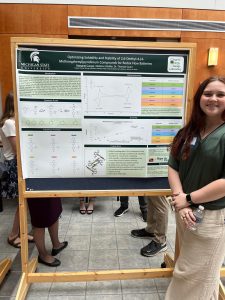Optimizing Solubility and Stability of 2,6-Diethyl-4-(4-Methoxyphenyl)pyridinium Compounds for Redox Flow Batteries
Margaret Cooper, Madison Shaffer, Thomas Guarr
As the demand for renewable energy grows, the need for long duration energy storage has become critical. Redox flow batteries (RFBs) have emerged as a potential alternative for grid-scale energy storage as they are both safe and environmentally friendly. RFBs employ two electrolyte solutions (an anolyte and catholyte) and achieving commercially viable energy density in such systems requires that the anolyte displays a low reduction potential and high solubility. Previous research has shown that pyridinium compounds offer low reduction potentials, but varying solubilities and stability in their reduced states. This work focuses on 2,6-diethyl-4-(4-methoxyphenyl)pyridinium compounds with various 1-aryl substituents in an attempt to improve solubility and stability while maintaining a low reduction potential. These compounds are prepared via condensation of 2,6-diethyl-4-(4-methoxyphenyl)pyrylium with the desired aryl amine. Solubilities were measured by UV-visible spectroscopy, while radical stability was measure by cyclic voltammetry.
Maggie attends Montana State University and we were lucky to have her join us at the OESLab in Holland this summer. She is a lot of fun to have around and she is up for anything, including a lot of synthesis projects and analysis. Thanks for being a trooper! Enjoy the rest of your summer and enjoy returning to Big Sky country!


